
/all-in-one-pcs-832299-11ccd91ece5d4f4e9fd9bb552ce51394.png)
Your PC is now looking for available devices to project onto.Select the “ Connect” button on the Notifications tab.Firstly, click on the Notifications/Action icon, found in the bottom right-hand corner of the taskbar (The speech box in the bottom right next to the time).Steps For The Main PC That You Want To Use Alongside The Laptop – This is all the setup required from the laptop side of things, now go to your main computer.The first drop-down menu needs to be set to available, allowing other devices to project onto it.Find and click on “ Projecting to this PC” option in the menu on the left-hand side.Inside Settings, find and select “ System” icon.Click the Start menu and go into “ Settings” (The gear icon).Here’s how: Steps For The Laptop You Wish To Use – We’re going to use Miracast to transform your laptop into a secondary monitor. The first method requires using the built-in Windows feature, Miracast. The methods will range from using built-in Windows features to make your laptop a secondary display, to streaming a game onto your laptop from your desktop. In this easy step-by-step guide, we’re going to show you a number of different ways to use your laptop as a second monitor and the benefits of doing so. Don’t worry, though, this method is still extremely simple to complete. If you want to use your laptop as a secondary monitor, we’re going to have to take an alternative route. You can use it to display your laptop image on a monitor or TV, which is great, but not what we’re looking to do here. The HDMI output on your monitor, is precisely that, an output. Most people reading this will probably think using your laptop as a secondary monitor is as simple as connecting your desktop to your laptop via an HDMI cable. Well, fear not, using a laptop as an additional monitor is now easier than ever and we’re going to walk you through exactly how to do it. This being said, just like buying a new GPU for your already fully functional gaming PC, purchasing an extra monitor solely for a dual display setup can be a hard pill to justify. No longer will you have to squeeze all your applications onto one screen or prioritize certain applications over others.

It can open up a whole new window of opportunity both physically and metaphorically. Having an extra monitor at your disposal is a fantastic way of boosting work productivity.


 0 kommentar(er)
0 kommentar(er)
